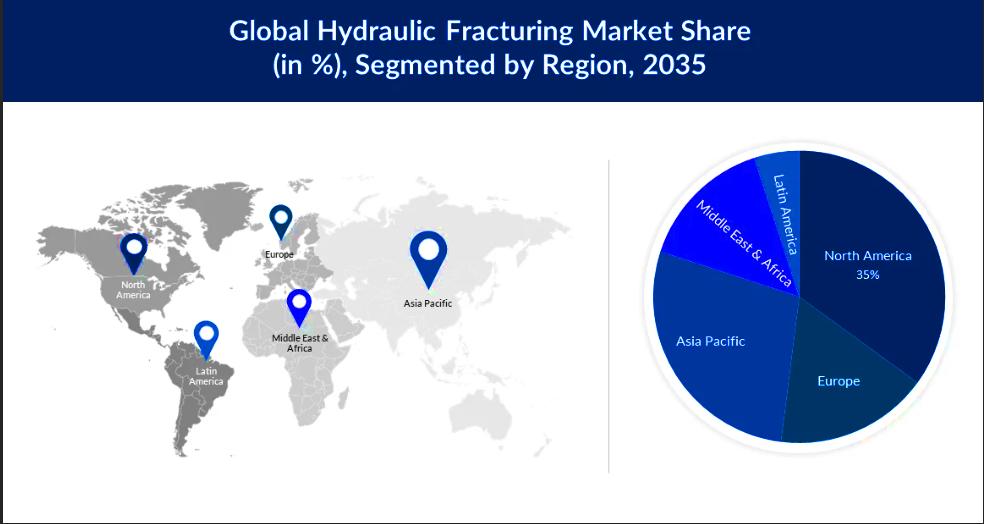- English
- Español
- Português
- русский
- Français
- 日本語
- Deutsch
- tiếng Việt
- Italiano
- Nederlands
- ภาษาไทย
- Polski
- 한국어
- Svenska
- magyar
- Malay
- বাংলা ভাষার
- Dansk
- Suomi
- हिन्दी
- Pilipino
- Türkçe
- Gaeilge
- العربية
- Indonesia
- Norsk
- تمل
- český
- ελληνικά
- український
- Javanese
- فارسی
- தமிழ்
- తెలుగు
- नेपाली
- Burmese
- български
- ລາວ
- Latine
- Қазақша
- Euskal
- Azərbaycan
- Slovenský jazyk
- Македонски
- Lietuvos
- Eesti Keel
- Română
- Slovenski
- मराठी
- Srpski језик
Global Hydraulic Fracturing Market Size, Forecast, and Trend 2023–2035
2023-11-09
Market size, by the end of 2035, the hydraulic fracturing market will have surpassed usd 62 billion and be expanding at a cagr of 7% over the forecast period from 2023 to 2035. hydraulic fracturing's global market size in 2022 was about 35 billion usd. the rising cost of crude oil can be attributed to the market's expansion. All over the world, crude oil prices have risen to over usd 80 per barre. Businesses can spend more money on unconventional resource extractor technologies like hydraulic fracturing as oil and gas prices rise. In addition to these, it is thought that the expansion of petroleum refineries will also contribute to the hydraulic fracturing market's expansion. There are currently 825 active refineries worldwide, and between 2023 and 2027, this capacity is predicted to increase by about 15%.

Hydraulic Fracturing Market: Key Insights
|
Base Year |
2022 |
|
Forecast Year |
2023-2035 |
|
CAGR |
~7% |
|
Base Year Market Size (2022) |
~ USD 35 Billion |
|
Forecast Year Market Size (2035) |
~ USD 62 Billion |
|
Regional Scope |
· North America(U.S. and Canada) · Latin America(Mexico, Argentina, Rest of Latin America) · Asia-Pacific (Japan, China, India, Indonesia, Malaysia, Australia, Rest of Asia-Pacific) · Europe(U.K., Germany, France, Italy, Spain, Russia, NORDIC, Rest of Europe) · Middle East and Africa(Israel, GCC North Africa, South Africa, Rest of the Middle East and Africa)
|

Hydraulic Fracturing Market: Growth Drivers and Challenges
• Rising oil and gas investment: from 2015 to 2023, the global investment in oil and gas exploration and extraction reached an all-time high of usd 528 billion. By increasing investment, oil and gas companies can expand their fracturing operations to reach new deposits and increase production.
• Increasing Global Energy Demand - According to The International Energy Agency (IEA), the demand for oil will reach a new high of 102.1 million barrels per day (bpd) in 2023. More oil and gas production is required to meet rising demand as the world's energy demand rises.
• Growing Per Capita Income - As per capita income rises, so does the standard of living. This frequently resulted in an increase in the need for water, electricity, and transportation, which in turn raised the demand for energy.
Challenges
• Environmental Concerns Associated with Hydraulic Fracturing - The fracturing caused various harms to the environment such contamination of water, emission of methane, and even put pressure on the land and induce seismicity. All these concerns are imposing huge challenges to market growth.
• Geographical Hindrance to The Procedure
• Substantially High Usage of Water

Hydraulic Fracturing Segmentation
Well Sites (Onshore, Offshore)
In the upcoming years, it is anticipated that the onshore segment will control 60% of the global hydraulic fracturing market. The increase in new discoveries in the onshore wells is to blame for the segment's expansion. To continue exploring in the onshore wells, Norway obtained new 54 licenses. Lndia and Egypt then obtained 29 and 11. In order to increase oil production, hydraulic fracturing is used in onshore wells for both natural gas extraction and microbially enhanced oil recovery.
Fluid Type (Sick Water-Based, Foam-Based, Gel-Based)
During the anticipated period, the foam-based segment of the hydraulic fracturing market is expected to grow by a sizeable share of about 46%. Of all the fluid types used in the process, foam is thought to be the most suitable. The need to take a sustainable approach is blamed for the segment's expansion. Foam-based areas are the most practical due to a severe water shortage. Additionally, they are appropriate for formation in water-sensitive environments.
Hydraulic Fracturing Industry- Regional Synopsis
North American Market Forecast
By the end of 2035, North America's hydraulic fracturing market is expected to be the largest, with a 35% market share. The region's expanding reserves are a major factor in the market growth. The nation's current reserves total 8.2 billion metric tons. 3.7 billion tonnes, an increase from the decade's beginning. In addition. Market expansion in the area is also anticipated to be fueled by the expansion of advanced machinery oil extraction.
APAC Market Statistics
In the near future, it is anticipated that the hydraulic fracturing market in the Asia Pacific will register a share of about 28%. The expanding trade in oil and gas from the area is a major factor in the market's expansion. Due to improved transportation, China is expected to import the most crude oil by the end of 2023. following the COVID-19 restriction's relaxation. The demand for liquid fuels would increase by roughly 50% and 30%, respectively, for petroleum and jet fuel.





